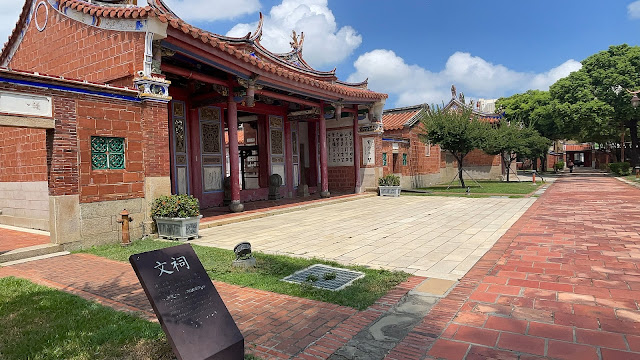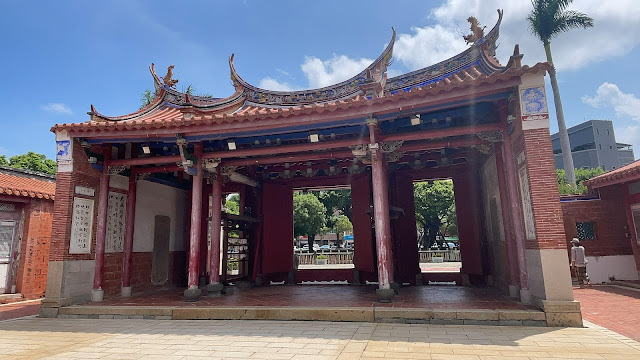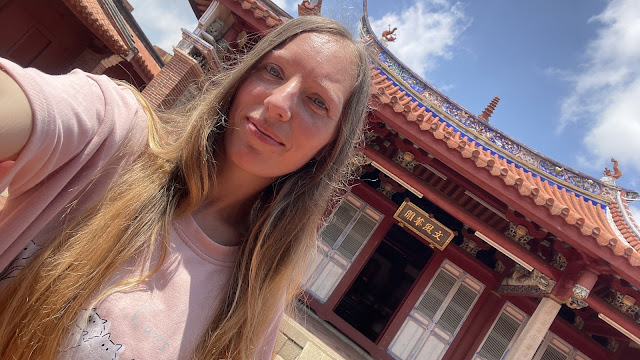Travel Date: 2024/07/20
Just a few days before the arrival of Typhoon Gaemi, we took a trip to Lukang, Changhua. It's one of my favorite towns to visit because it's steeped in historical buildings, much like Tainan. One day isn't enough to see it all! We wandered through some narrow lanes and visited Lukang Old Street, which was bustling with activity. Along the old street, you can see many buildings from the Qing Dynasty. I love the architecture because it looks so different from what we see today. Although my all-time favorites are the buildings left from the Japanese occupation, many people dislike them, and I often get angry reactions when I post about them on Facebook. Well, it's part of Taiwan's history now, so why not cherish it? They look unique and attract many tourists. Taiwan has turned many Japanese relics into popular tourist areas, and Japan is the top country Taiwanese people travel to, so why hate on it?
Anyway, back to the topic. We spent the day discovering old places in Lukang. The weather was hot—very hot—as it reached at least 34 degrees Celsius, not to mention the actual heat when you walk in full sun.
Our first stop was Wenwu Temple, which we last visited about six years ago. Time flies so fast. Part of the temple was under renovation, but the area is quite large, so there were still plenty of places to visit, and the renovation didn't bother us at all. The temple has free parking, which made it convenient to stop by.
Later, we headed into town. On the way, we saw an old train station building that is now a care center. After equipping ourselves with some cold drinks and asking for food recommendations, we moved on. We tried one of the famous baozi shops, but I didn't enjoy it—the bun was like air, and there was barely any filling. Honestly, I couldn't taste any flavor. It's a tourist-famous shop, and from my experience, all tourist spots and popular shops are just expensive and not tasty—at least in my opinion.
While searching for Lukang Old Street, we passed through Jiuqu Lane. At the end, there was a market where we tried some noodles. Although my husband said the flavor was different from others, I liked it. Nearby, there was a popular shaved ice shop, but we were already full, so we skipped it and continued. We walked through Lukang Old Street, visited a paper art exhibition, and explored the Lukang History Museum, which is housed in an old Japanese-era dormitory. Scrolling through Google Maps, I noticed a Japanese shrine, so we went to check it out.
Walking through another small lane, we visited Heqi Villa, a house that belonged to a wealthy family during the Qing Dynasty. Something I had never seen before was a well inside a house. The shrine is actually next to it, and reading the reviews, it turns out to be an art installation set up in 2022.
Another place we visited was the Ding Family Mansion, which is really large—probably one of the largest houses we have ever seen. The area has a front entrance on Zhongshan Road, a busy place, but the entrance from the back is very empty and quiet. There's also a place to park at the back, so it's probably easier to start from there.
We ended our trip with a stop in Erlin, where we had never been before. We ate at a jīpái shop called HFC, which I highly recommend because the chicken was big and extra juicy. We also visited an elementary school to see several Japanese-era buildings. One of them reminded us of a building we saw at Jingliao Elementary School (you can check it out HERE).
That concluded our trip, which was really fun but tiring due to the heat.
Lukang Travel Part II [LINK]
Erlin Travel [LINK]
Wenwu Temple (鹿港文武廟)
Wenwu Temple is a fascinating 3-in-1 site where you can explore the Wenchuan (Wenkai) Academy, Wenchuang Shrine, and the Martial Temple. Lukang, the oldest city in Changhua, was a crucial seaport in the 18th century and the second-largest city in Taiwan at that time. Today, Lukang is celebrated as one of the ten small tourist towns in Taiwan.
In Lukang, you'll find many historic temples like Longshan Temple and Mazu Temple. The city boasts over 200 temples dedicated to various deities. The terms "ekang" (下港) and "tengkang" (頂港) originated here, referring to the south and north of Taiwan, meaning "below the harbor" and "above the harbor," respectively.
The Wenwu Temple complex is a mix of literary and martial arts temples, featuring the Wenkai Academy on the left, the Wenyu Temple in the center, and the Wu Temple on the right, each built at different times. The Wenyu and Wu Temples were constructed in 1812, while the Wenkai Academy was established in 1824.
The Wu Temple is dedicated to Guansheng Dijun and uniquely does not have Door God paintings on its doors, unlike many official temples. The Wenchang Shrine was where Lukang's literati gathered to form Ba She, the first association to study poetry. The shrine is dedicated to the God of Scholarship, Wenchang; the Creator of Chinese Characters, Cang Jie; and the God of Literature, Kuixin.
During the Japanese occupation, the Wenwu Temple served as a military camp and a classroom for Lukang Public School. In 1914, twenty-five people donated money for its renovation. Some buildings were destroyed by fire in 1975, but they were rebuilt ten years later, albeit not in their original form.
Train Station (鹿港車站)
The Taiwan Sugar Corporation's small train was built during the Japanese colonial era. Originally, its primary purpose was to transport sugarcane and sugar. However, the Lukang Station that you see today is not the original sugar railway station - the original station was dismantled after the decline of the sugar industry. Although the current Lukang Station is not a functioning passenger station, its beautiful scenery and nostalgic atmosphere have made it a popular new tourist attraction in Lukang.
The exterior of Lukang Station is a quaint wooden structure, complemented by lush trees that give it an elegant and serene ambiance. Inside the station, there's an open-style large train engine, manufactured in Japan in 1961.
Jiuqu Lane (九曲巷)
Jiuqu Lane, also known as Jinsheng Lane, was historically designed with winding and meandering pathways to prevent bandit invasions and mitigate the destructive Nine Winds. This unique design earned it the reputation of "Curved Lane in Winter Sunshine." Visitors to modern Jiuqu Lane can still experience its intriguing spatial arrangement. Within the lane, there is an overhead corridor connecting both ends, leading to the legendary gathering place for scholars known as "Shiyi Tower." Adjacent to it is an early defensive structure.
Lukang Culture Center (鹿港公會堂)
The Lukang Public Hall, designated as a county historic site since July 14, 2000, was formerly the Xiajiao Guild Hall and the Wanchun Palace, dedicated to the prince of the Su Mansion. In 1919, the temple was demolished to construct the public hall. After World War II, the hall was renamed "Zhongshan Hall" and served as the office of the Lukang District Party Office of the Kuomintang. In 1980, local residents raised funds to rebuild the hall, opening as the Lukang Elderly Guild Hall in 1981. In 2007, renovations led to the hall becoming the Lukang Art Museum on March 13, 2010.
Lukang Museum of History (鹿港鎮史館)
The Lukang Street Dormitory, built in 1935 during the Japanese occupation, initially housed the "Jiyuechang" administrative organization that oversaw Lukang. The first Lukang street chief was Chen Huaicheng, and the dormitory was constructed during Yoshida Jjiro's tenure as the second street chief. Post-war, the building served as a staff dormitory and warehouse for the Lukang Town Office. It was designated a historic building in 2002 and restored in 2004.
The dormitory is a Japanese-style all-wood building, reflecting the architectural style of Lukang during the Japanese occupation. It has since been repurposed as the Lukang Town History Museum, showcasing literature, history books, and old photographs of Lukang.
Address:
1. Wu Temple: 505彰化縣鹿港鎮青雲路2號
2. Lukang Station: 505彰化縣鹿港鎮彰鹿路八段110號
3. Jiuqiu Lane: 505彰化縣鹿港鎮金盛巷
4. Culture Center: 505彰化縣鹿港鎮埔頭街72號
5. Museum of History: 505彰化縣鹿港鎮民權路160巷2號
%202%20(2).jpg)


























0 komentarze:
Post a Comment